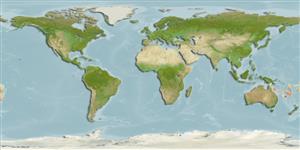Ikan bertulang rawan (sharks and rays) >
Carcharhiniformes (Ground sharks) >
Pentanchidae (Deepwater catsharks)
Etymology: Parmaturus: parma (L.), from parme (Gr.), small shield; oura (Gr.), tail, presumably referring to upper edge of caudal fin “armed with modified” scales (per Garman 1913). (See ETYFish); albipenis: albus (L.), white; penis (L.), copulatory organ, referring to white claspers, which contrast strongly against dark brownish body coloration. (See ETYFish).
More on authors: Séret & Last.
Environment: milieu / climate zone / depth range / distribution range
Ekologi
laut batidemersal; kisaran kedalaman 688 - 732 m (Ref. 74543). Deep-water
Western Pacific: New Caledonia.
Size / Weight / umur
Maturity: Lm ? range ? - ? cm
Max length : 41.5 cm TL jantan/; (Ref. 74543)
deskripsi pendek
Morfologi | Morfometrik
This scyliorhinid catshark is distinguished by the following set of characters: a soft body with velvety skin, with small, tricuspidate denticles; whitish claspers, contrasting with the brownish body coloration; presence of caudal crests but denticles are not enlarged, the crests reaching almost to second dorsal and anal-fin insertions; teeth tri- or quadricuspidate, in the upper jaw about 130 rows; first dorsal fin slightly in front middle of back, pre-first dorsal length 46.2% TL, origin slightly in front of pelvic-fin origin; pelvic-fin origin slightly in front of midbody, pre-pelvic length 47.1% TL; vent slightly behind mid-body, pre-vent length 52.0% TL; short snout, prenarial length 4.3% TL; short mouth, its length 3.1% TL; very short labial furrows, confined to mouth corners; head is shorter than abdomen, head length 19.8% TL, pectoral-pelvic length 24.2% TL; dorsal fins are large, subequal in size, anterior margins about 11.3% TL, with the first dorsal more erect than second; well-developed subterminal caudal lobe , subterminal margin length 5.7% TL, terminal margin length 5.1% TL; 39 monospondylous centra; 79 precaudal centra, 123 total (Ref. 74543).
Life cycle and mating behavior
Kematangan | Reproduksi, perkembang biakan | Pemijahan | telur-telur | Fecundity | Larva
Séret, B. and P. Last, 2007. Four new species of deep-water catsharks of the genus Parmaturus (Carcharhiniformes: Scyliorhinidae) from New Caledonia, Indonesia and Australia. Zootaxa 2007:1-17. (Ref. 74543)
Status IUCN Red List (Ref. 130435)
ancaman kepada manusia
Harmless
penggunaan manusia
informasi lanjut
Nama-nama umumSinonim (persamaan)metabolismePemangsaEkotoksikologiReproduksi, perkembang biakanKematanganPemijahanSpawning aggregationFecunditytelur-telurpekembangan telor
Umur / SaizPertumbuhanpanjang-beratpanjang-panjangukuran frekuensiMorfometrikMorfologiLarvaDinamika larvapemulihanKelimpahanBRUVS
AcuanBudidaya airprofil budidaya airStrainGenetikaElectrophoresesDiturunkanPenyakit-penyakitPengolahanNutrientsMass conversion
mitraGambarStamps, Coins Misc.Suara-suaraCiguateraKecepatanTipe renangArea insangOtolithsOtakPenglihatan / visi
Alat, peralatan
laporan khas
muat turun XML
Sumber internet
Estimates based on models
Preferred temperature (Ref.
123201): 5.8 - 7.1, mean 6.1 °C (based on 7 cells).
Phylogenetic diversity index (Ref.
82804): PD
50 = 0.5010 [Uniqueness, from 0.5 = low to 2.0 = high].
Bayesian length-weight: a=0.00355 (0.00176 - 0.00714), b=3.09 (2.91 - 3.27), in cm total length, based on LWR estimates for this (Sub)family-body shape (Ref.
93245).
Trophic level (Ref.
69278): 4.0 ±0.6 se; based on size and trophs of closest relatives
Daya lenting (Ref.
120179): Tinggi, Waktu penggandaan populasi minimum kurang dari 15 bulan (Preliminary K or Fecundity.).
Fishing Vulnerability (Ref.
59153): Low to moderate vulnerability (32 of 100).
